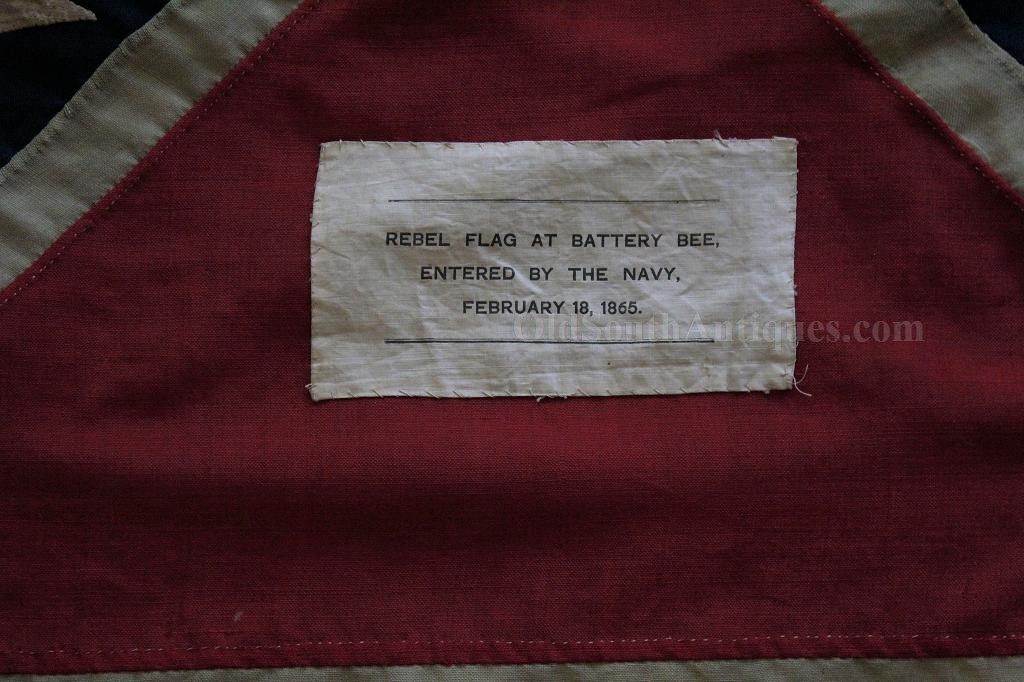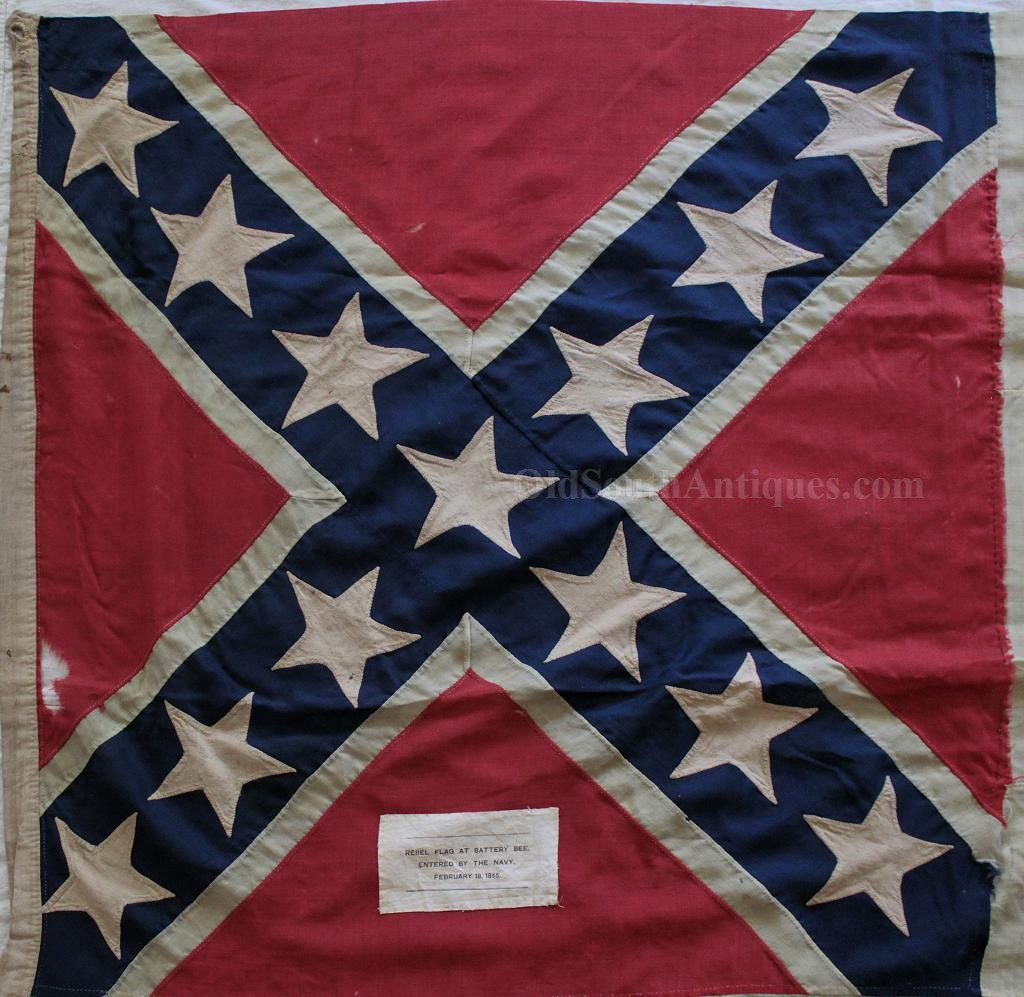
| Catalog | Past Items | Order Info | Terms/Conditions | About Us | Inventory Clearance |




This is how the flag would look, with only the canton showing in the frame.



Inked inscription on the hoist

Another inscription on the hoist.
The flag of the Confederacy rose and fell in only four years. It arose over a prosperous, peaceful nation whose mothers sent their husbands and sons to die, if need be, under its folds. And die they did, from the plains of Manassas to the fields of Pennsylvania, from Shiloh to Nashville, from the Wilderness to Appomattox and from Southern seaports to the shores of distant lands.
The flag the Confederacy adopted as its National Standard on March 4, 1861 was first raised on Capitol Hill in Montgomery, Alabama. The honorable Jefferson Davis, ex-U.S. Secretary of War and new president of the Confederacy, invited Letitia Christian Tyler to raise the first official flag of the new Confederacy. Miss Tyler had been born in the White House, the capitol of the United States. She was the granddaughter of ex-U.S. President John Tyler. The seven star flag Miss Tyler raised that day has come to be known as the First National Confederate Flag, or the Stars and Bars. The circle of seven stars in the canton represented the seven Southern States that had seceded up until that time: South Carolina, Mississippi, Alabama, Florida, Georgia, Louisiana, and Texas.
As disunion became a reality and war fever swept the nation in the late winter and spring of 1861, countless towns, communities, and counties formed local military units, or companies, in hopes of participating in the coming conflict. Lincoln’s illegal demand that the Southern States aid in subjugating her sister states had forced another six states to secede. Virginia on April 17th, Arkansas, May 6th, Tennessee, May 7th, North Carolina, May 20th, Missouri, August 5th, and Kentucky on November 5th. A star was added to the Confederate National Flag for each new state that joined the Southern Confederacy.
During the Battle of Manassas, it became obvious that the Confederate First National "Stars & Bars” would not do on the battlefield; it was too hard to tell it from the old "Stars and Stripes”. It had intentionally been similar to the flag their forefathers fought under, but a distinct, soldier’s flag was needed and what we now know as the Battle Flag was the result.
After two years of war, there was only hate for the old Stars and Stripes, so by an act of congress, signed into law by the president on May 1, 1863 a new flag was selected. After some last minute alterations, the final design was the "Stainless Banner”. It was part soldier’s flag and part national flag. The canton consisted of the battle flag, and the field a pure white, symbolizing the purity of the Confederate cause and her people.
The Second National Flag was used as a National, and also as a Regimental, Battle flag, by both the Eastern and Western Armies. Much more is known about the military issued flag shown here than the vast majority of Confederate flags. Brigadier Randal Gibson ordered new flags for his brigade in November of 1863. He sent a Lieutenant to Mobile, Alabama to acquire the flags, and he gave some very specific instructions: each flag was to be specifically detailed for each regiment. The regimental designation was to be applied to the flag, and for the regiments that had fought honorably at a given battle, they were to have the names of those battles emblazoned on their colors. Also, any regiment that had assaulted and took an enemy artillery battery was to have this gallant deed acknowledged by applying crossed cannon to the field. These flags were made by Jackson Belknap of Mobile.
There can be no doubt that having the record of each regiment waving in the storm of battle for all to see, inspired pride and competition between the regiments. It was a wise decision by General Gibson.
Noted flag historian Dr. Howard Madaus wrote a report on the flag on November 26, 2003, from which much of the information below is taken.
This flag measures 64½" on its hoist
by 92½" on the fly (worn down from 96"), including 1¼" linen
hoist binding, constructed of bunting with 7" linen stars which are inset
with a welt and visible from both sides. Hand whipped grommets are at the top and
bottom corners, with a 7" x 11" white reinforcing strip by the lower
grommet and a 3" x 6" blue reinforcing panel at the top. The canton features the Army of Northern
Virginia Battle Flag and is 46" square. The white field is composed of four strips,
three 18" and one 10", and there is no fold over on the top or bottom
edge. The flag is completely hand
stitched. Written in ink toward the lower
corner of the hoist is "Battery Bee 1 Jany 1864" and at the
upper corner "6 x 10." Stitched to the flag on the lower center red
portion of the canton is a 4½" x 8" polished cotton rectangle which
bears the printed legend: "Rebel Flag Battery Bee/ Entered By The
Navy,/ February 16, 1865." The
date refers to the day Union forces entered the Charleston defenses. According to an evaluation written by Dr.
Howard Madaus, "As the flag conforms to the style and size of the type produced
for 'posts and camps' by the Confederate Clothing Depot at Charleston, S.C.,
there is no reason to doubt the ascribed history written on this cotton
patch." Doubtless this flag appears
exactly as it was when removed from Battery Bee with one small tear along the
hoist, the edge of the fly somewhat tattered, and a section of stitching that
has opened along one side of the canton.
Battery Bee was located in
Charleston Harbor. The Report of Captain
Warren Adams dated November 20, 1863, indicates that Company I of the 1st South
Carolina Regular Infantry, also known as the 3rd South Carolina Heavy Artillery
occupied the fortifications and took casualties on November 19, 1863. This would have been a mere six weeks prior to
the issue of the flag. There are no
records of that regiment being moved from their position although there may be
later reports of Battery Bee held by others after the evacuation. After several attempts Battery Bee was finally
captured by the U.S. Navy on February 16, 1865.
The flag itself conforms to the Army
revisions of the national flag adopted by the Confederate Congress on May 1,
1863, commonly referred to during the period as the Stainless Banner.
When the flag was issued in January, 1864, the forces that held "Battery Bee" were probably members of Company I, 1st South Carolina Regular Infantry, also known as the 3rd South Carolina Heavy Artillery (see the report of Captain Warren Adams, dated 20 November 1863, regarding the casualties incurred at "Battery Bee" on 19 November 1863, Official Records of the War of Rebellion, Series I, Vol. 28, Pt 1, p. 744). Companies C and H were also garrisoned at the battery at some point.
Battery Bee, so named under General Order dated November 4, 1862, to honour South Carolina General Barnard Elliot Bee, who so famously coined the term "Stonewall” before being mortally wounded at 1stManassas, was situated on the "western extremity" of Sullivan's Island west of Fort Moultrie and designed to guard Charleston Harbor. Progressively enlarged, and mounting up to 11 heavy guns, the Battery was initially commanded by Lt. Col. Lawrence M. Keitt, of the 20th South Carolina Infantry, who later gave his life at Cold Harbor. By May, 1864, the Battery was commanded by Major Warren Adams, 1st South Carolina Regular Infantry with two companies.
The Battery guns engaged Federal Naval forces on several occasions in 1863-64 with slight loss (detailed reports found in OR's). The city of Charleston and Battery Bee were evacuated on February 17, 1865 in orderly fashion (guns disabled, some critical stores withdrawn) and occupied by Federal troops under General Quincy Gillmore on February 18, 1865. The flag was no doubt left flying in order to fool the Yankees that the battery was still occupied. No specific mention of the flag from Battery Bee is found in the Official Records though we can assume that once the defenses of Sullivan's Island collapsed, the flags of all of the batteries on the island were quickly seized. On February 18th, Lt. Colonel A.W. Bennett of the 21st US Colored troops, reported that troops under his command had occupied Charleston and secured the flags of Fort Moultrie, Castle Pinckney, Fort Ripley, and seventeen signal pennants found in the city (Official Records, Chapter LIX: 1019).
The flag’s current history can be traced back to Paul Verkamp of Cincinnati, Ohio, who loaned it to Lloyd L. Howard of the same city. It is understood that it was returned to the former's possession in October of 1995 after Mr. Howard's death. At the time of Mr. Verkamp's death, the flag was sold by Heritage Auctions in December, 2016 for $40,000.00. See: https://historical.ha.com/itm/military-and-patriotic/civil-war/confederate-second-national-flag-the-stainless-banner-captured-at-battery-bee-in-charleston-harbor-on-february-16-1865/a/6160-40250.s
Our price is only $31,000.00. For an additional 5k, the flag will be conserved and framed, and delivered to any state in the continental U.S. The flag is large, and requires a large space, however the battleflag in the canton is just about the same size as a standard issue Army of Northern Virginia pattern, it being only two inches larger, and can be framed with only the canton showing, if so desired by the purchaser. I have included a picture of just the canton so that you can see how it would look.
Copyright © 2025 OldSouthAntiques.com All Rights Reserved.
Privacy Policy | Terms of Use
Powered by Web-Cat Copyright © 1996-2025 GrayCat Systems